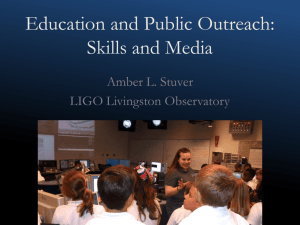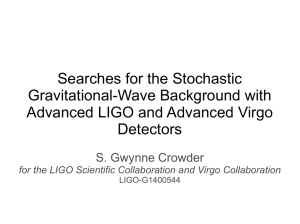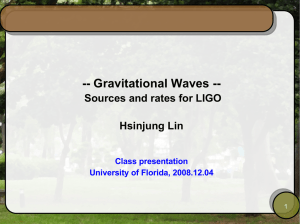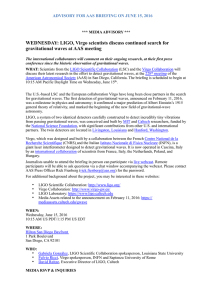The direct detection of Gravitational Wave
advertisement
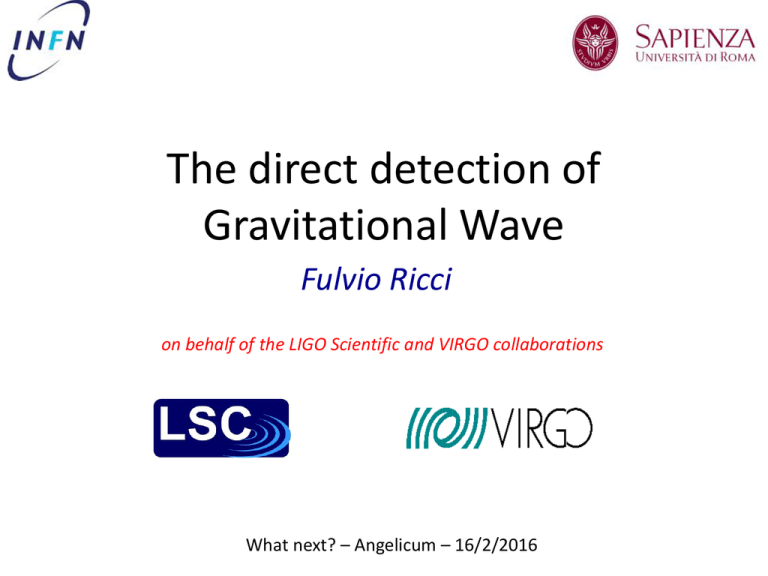
The direct detection of
Gravitational Wave
Fulvio Ricci
on behalf of the LIGO Scientific and VIRGO collaborations
What next? – Angelicum – 16/2/2016
A bit of history
• The LIGO project was approved in 1992 and inaugurated in 1999.
Built at a cost of almost 3x108 $, LIGO was the largest single
enterprise ever undertaken by the foundation. It started the
operation in 2002.
• VIRGO was formally proposed in 1989 and approved in 1993. The
construction was divided in two step: it started in 1996 and then
completed in 2003. The first science run is date 2007. The total
investment done by CNRS and INFN was almost 8 x 107 $.
• GEO600 was proposed in 1994. Since September 1995 this BritishGerman GW detector was under construction. The first science run
was performed in 2002. In 2013 Squeezing light was used over one
complete year!
• First attempt to exchange data and mix the data analysis groups
started in 2004. The formal MoU of data sharing and common
analysis among GEO-LIGO-VIRGO was signed in 2007.
The 2007 GW network
H1- Hanford – Washington state
GEO600 – Hannover - Germany
Virgo – Cascina (Pisa) – EGO site
L1- Livingston – Louisiana state
CW and stochastic signal searches
• For Crab and Vela pulsars we are below the “spin-down limit”:
constrain the fraction of spin-down energy due to GW
J0534+2200
[Aasi et al. ApJ 2014]
Pulsar
h95%
e
J0534+2200 1.8(1.6)x10-25 9.7(8.6)x10-5
J0835-4510 1.1(1.0)x10-24 6.0(5.5)x10-4
• Upper Limits on the Stochastic
Gravitational-Wave Background
[PRL 113, 231101 (2014)]
LIGO upgrade concluded
The Advanced LIGO
dedication ceremony was
held at Hanford on May
19, 2015
H1- Hanford – Washington state
VIRGO will end
the upgrade
in 2016
L1- Livingston – Louisiana state
Compact Coalescing Binaries
Detection perspectives with advanced detectors
Phys. Rev D85 (2012) 082002GW
data
Mandel 2015
Models
Probe beyond local universe
100 M⊙ + 100 M⊙ BBH
visible out to ~16 Gpc at design
sensitivity (~5 Gpc in O1), even
further if the source is spinning
The event
• On September 14, 2015 at 09:50:45 UTC the
LIGO Hanford, WA, and Livingston, LA,
observatories detected a coincident signal.
• The event was flagged as GW150914
• Exhaustive investigations of instrumental and
environmental disturbances were performed,
giving no evidence that GW150914 is an
instrumental artifact
Binary Coalescence search
Search for GW emission by binary system: total mass range 1- 99 M
> 4 M Model based on PN, BH perturbation theory and NR
~ 2.5 x 105 wave forms used to cover the parameter space
SNR of the Matched filter computed as function of time r(t) and identify
maxima and calculate c2 to test consistency with the matched template,
then apply detector coincidence within 15 ms
Calculate quadrature sum rC2(t) = rH2 (t) + rL2 (t) of the SNR of each
detector
Background computed by shifting 107 times equivalent to 608,000 years
Combined SNR = 23.6 , FAR = 1/203,000 years 5.1 s
Combined SNR = 23.6 , FAR = 1/203,000 years 5.1 s
The Parameter Estimation
Estimated GW Strain Amplitude: GW150914
Full bandwidth waveforms
without filtering. Numerical
relativity models of black hole
horizons during coalescence
Effective black hole separation in
units of Schwarzschild radius
(Rs=2GM/c2); and effective
relative velocities given by postNewtonian parameter v/c =
(GMpf/c3)1/3
Source parameters for GW150914
Estimated source parameters from GW150914. We report median values with 90%
credible intervals that include statistical errors from averaging the results of
different waveform models. Masses are given in the source frame: to convert in the
detector frame multiply by (1+z). The source redshift assumes standard
cosmology: DL z assuming LCDM with H0 = 67.9 km s-1 Mpc-1 and Wm =0.306
Few Companion Results
Astrophysical implications (accepted on ApJL)
• GW150914 demonstrates the existence of stellar-mass black holes of M > 25M,
– binary black holes can form in nature and merge within a Hubble time
• Binary black holes have been predicted to form both in isolated binaries and in
dense environments by dynamical interactions .
• Formation of such massive black holes from stellar evolution
– weak massive-star winds, and stellar environments with metallicity lower
than 1/2 the solar value
Event rates evaluation 2–400 Gpc -3 yr -1
• Considering only GW150914 event and assuming that the BBH merger rate is
constant in the comoving frame, we infer a 90% credible range of 2–53 Gpc -3 yr 1 (in the comoving frame)
• Incorporating all triggers that pass the search threshold (independent of their
astrophysical origin) and several other models, we obtain rate estimates ranging
from 6–400 Gpc -3 yr -1
Stochastic back. of astrophysical origin
• Superposition of unresolved GW emission of binary black hole sources at larger
distances.
-9 with 90% confidence.
• Prediction W GW (~ f = 25 Hz) 1.1+2.7
x
10
-0.9
• Potentially measurable by the Advanced LIGO/at their projected final sensitivity
Testing General Relativity
• The phase of the gravitational waveform during the inspiral can
be ex- pressed as a power-series in f 1/3 .
• The coefficients of this expansion can be computed in general
relativity
-GR test : allow the coefficients to deviate from the nominal GR value
Comparison, the blue triangles show the 90% upper bounds extrapolated
exclusively from the orbital-period derivative, P ’̇ orb , of the double pulsar
J0737- 3039.
Compton Wave-length of the Graviton
C. M. Will, Phys. Rev. D 57, 2061 (1998).
• We assume a modified dispersion relation for gravitational waves
(vg /c)2 = 1 − {h c /(λgE )}2
•
In the massive graviton theory an extra phase term is added to the CBC evolution
(formally a 1PN order term)
f MG( f ) = −(p D c) / [ lg 2 (1 + z) f ]
• Our constrain on the 1PN terms permit to derive a down limit for the
Compton wavelength of the graviton
l g = h / (mg c ) > 1013 km
• It corresponds to a limit mg < 1.2 x 10-22 eV/c2.
– limit better than that set by Solar System observations
– thousand time better of the binary pulsar bounds
– worse than bounds from dynamics of galaxy clusters and weak lensing
observations (model- dependent bounds)
Conclusion
P HYSICAL
REVIEW
L ETTERS
Ô
Member Subscription Copy
Library or Other Institutional Use Pr ohibited Until 2017
Articles published week ending
12 FEBRUARY 2016
Published by
American Physical SocietyÔ
We detected Gravitational Waves
by a binary BH system
Volume 116, Number 6

